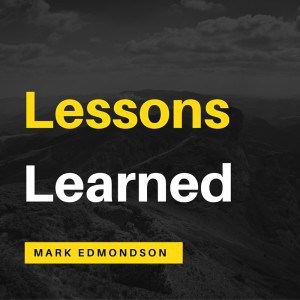Mark Graban's Note: Today is the first in a new series of posts by Mark Edmondson. See all of his past Lean Blog posts. If you like this topic of reflections and lessons learned, check out my collaborative eBook project “Practicing Lean.”

As a Lean change agent, I've made a lot of mistakes. Some mistakes I recognized early and recovered from; others were a blind spot that affected outcomes and success of the assignment. A few still haunt me from time to time when I suffer a case of “woulda, coulda, shoulda.”
In the spirit of sharing, and as personal therapy, I've asked Mark Graban if I may reflect on some lessons I've learned over the years as a Lean change agent in a series of posts on his blog. If you're feeling vulnerable and are comfortable admitting to mistakes, please comment with your lessons as well.
The first mistake I'd like to share: Not securing executive ownership.
 I know what you're thinking: “Mark, how could you not understand the importance of executive ownership during a major Lean initiative? That's lesson #1 in change management 101, right?” Well, I thought I knew what this meant, but in reality I didn't really understand the energy of ownership.
I know what you're thinking: “Mark, how could you not understand the importance of executive ownership during a major Lean initiative? That's lesson #1 in change management 101, right?” Well, I thought I knew what this meant, but in reality I didn't really understand the energy of ownership.
Let me clarify with an example from years ago. I was asked to help the president of a semi-autonomous subsidiary of a Fortune 500 company. Years ago, this subsidiary was acquired by the parent company, yet maintained a separate facility, staff, and culture. The problem was that its largest customer, the parent company, wasn't happy with its delivery performance and quality.
As an expert Lean change agent, I thought I understood the problem right away. But I also understood the importance of executive ownership, so I asked the president to attend all reviews and briefings and be an advocate for changes recommended by the team. He agreed, and attended most key reviews.
The problem was that I facilitated the workshops, I organized the Gemba walks, I reported the metrics, I prepared the daily coaching, I set up the visuals, and I led the reviews. One day, I woke up and realized that the energy of ownership shifted – the president didn't own this; I did. Like most successful executives, the president knew how to delegate. He's a busy guy and Lean is just one of many initiatives, so delegate! And without saying a word, that's exactly what he did by limiting his involvement to attending key reviews. Before long, management associated me as the owner of the Lean “initiative.”
And since I wasn't their boss, commitment waned and progress stalled. Can you feel my pain?
What was my mistake? I was assertive, proactive, understood how to solve problems, and accepted responsibility like I thought a good change agent should. But as a Lean thinker, I didn't understand the energy of who's the owner. Establishing ownership begins with clearly communicating up front the president's role and my role:
President's role: Owner. Not sponsor, not reviewer, not advocate… but OWNER, with all the duties and responsibilities thereof. This includes accountability for success, and takes a lot of time and discipline.
My role as Lean change agent: Subject matter expert. I can recommend, teach, coach, inspire, affirm, organize, measure, mentor, argue, justify, analyze, recommend, facilitate, entertain, cajole, whine, support, acknowledge, and work really hard. But I can't own the company's Lean journey and its outcome. That would create the wrong energy and confuse people about the organization's priorities.
As a change agent, it's critical that you not own the company's Lean strategy. Maybe you have an important sounding title like “VP of Enterprise Lean,” or “Corporate Director of Operational Excellence,” or “Chief El Jefe Sensei.” No matter. Unless you have responsibility for success of the overall organization, you can't own its Lean journey. Figure out how to effectively convey to leadership their role as owner, what this means, and how it will transform their behaviors on a daily, weekly, and monthly basis. The company's success may depend on this; your credibility certainly does.
Today, when stepping into an engagement, I've learned to begin with a heart-to-heart talk with the executive sponsor and make sure he/she understands their role as owner. I make it ok for him to say, “You know, this looks like it will take a lot of my time and I'm just not ready to take this on.”
Or, they may decide to find another change agent who's a little more green and willing to own it.
Don't be that guy.
Stay tuned for my next mistake: Not aligned with vision, values and strategy.
Mark Edmondson
www.linkedin.com/in/MarkEdmondsonLeanLeader
What do you think? Please scroll down (or click) to post a comment. Or please share the post with your thoughts on LinkedIn – and follow me or connect with me there.
Did you like this post? Make sure you don't miss a post or podcast — Subscribe to get notified about posts via email daily or weekly.
Check out my latest book, The Mistakes That Make Us: Cultivating a Culture of Learning and Innovation:










Your points are spot on. I might add that it is also vitally important to secure this ownership before change begins. The challenge is that some CEOs personally believe that they do and will own it but their commitment disappears the first time they realize how hard change can be.
This is where a behavioral based assessment should be done as well as a job preview prior to inititating the change. Some leaders don’t have the personal traits to be a lean leader or need some remedial behavior changes. It would also be unfair to get a commitment from a leader without truly previewing what it takes to be a lean leader. Some will choose to opt out; others will want to change lean to fit their personal style. Perhaps the most damaging leader is the one who prefesses to fully support lean change but then delegates responsibility as a matter of “necessity” because of the “other” demands of the organization.
Good input.
Your point, “It would also be unfair to get a commitment from a leader without truly previewing what it takes to be a lean leader” is also spot on. As a trusted resource to the leader, it’s our duty to have an authentic conversation about this, and address any perceived gaps with the leadership team.
I have had a number of “limited successes” in my consulting career (I’m now retired from the fray by 10 years) and in every instance it revolved around the organization’s leader. I often think a Lean consultant should first have an in-depth education (not training) in the psychology of leadership and how to coach the current leader into becoming THE LEAN LEADER. Otherwise, you are wasting your life’s time and you can’t get that back.
I find your insights to be spot on. Reaching that place where the Leader is THE LEADER requires lots of work with the leader before you even begin the transfer of Lean knowledge to the other folks. So, to me, the question is how do you get the leader to see that and if he/she does not, do you take the assignment? I stopped taking those assignments.
Another challenge is helping the Leader to see what the possibilities are for his/her organization without it being implemented in the slightest. My later tactic was to take the Leader on some journeys to see great Lean in action (which was hard to find until the middle ’90’s). And to require some reading and long discussions about the trials, tribulations and requirement for a successful outcome. That came late for me (started Lean in 1986 before lots of folks had a clue about it) so I had only one or two of those very satisfying experiences before I called a halt to my consulting.
Wishing you continued great success. The USA sorely needs it. Far too much faux lean around.
“So, to me, the question is how do you get the leader to see that and if he/she does not, do you take the assignment? I stopped taking those assignments.”
Paul,
The energy is different when the change agent retains the option of taking an assignment. The option of saying leadership isn’t ready is maintained, perhaps the most valuable advice a change agent can provide.
It’s more complicated when working as an internal change agent, since saying “leadership isn’t ready” may not be what the boss wants to hear. This goes back to understanding who is the real owner of the transformation. Hopefully the boss is grateful when told he isn’t quite ready to begin, and knows you have his back.
Mark—you are absolutely right. Being an internal consultant is more difficult. I was that for about 20 years or so. My way was to establish written contracts with each manager I and my team worked with. And we made very sure they got all the credit. Which meant I had to have a strong, understanding and respected boss, which was the case. So, it can be done. When I went external, things shifted, that is sure the truth. It was more difficult and more fun at the same time.
Discussing the differences of being an external and internal change agent would make an interesting post/article in itself.
Agreed that would be an interesting topic to explore more.
I’ve been in both roles. Being an internal Lean change agent is the worst when you’re thrown into an area that doesn’t really have management support for Lean. When I was a free internal resource, the only possible ROIs on my participation were zero or infinity. And, sometimes leaders were OK with zero. Just ignore the internal Lean guy or do or say just enough to placate those who are sending you the help.
All in all, I like being an outside change agent better for a number of reasons.